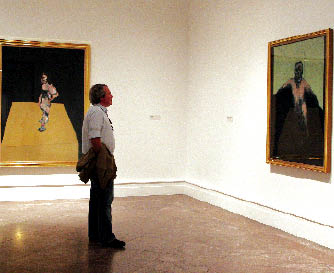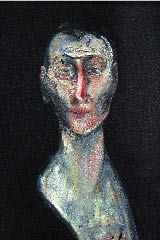Next story: Free Will Astrology
The Organic Mr. Bacon
by Eric Jackson-Forsberg




“RAW HUMAN EMOTION,” announces the banner for the exhibition Francis Bacon: Paintings from the 1950s, now at the Albright-Knox Art Gallery. Raw is the operative word for this look at Bacon’s formative decade, an aptly visceral adjective that may be applied to the artist’s brutally painterly technique, his slaughterhouse imagery, or his unflinching look at the unprocessed side of human nature.
This slogan has the ring of a sensational movie review (“Raw Human Emotion!” raves USA Today) but this media comparison is fitting. Film, it so happens, was an important influence on Bacon’s early work. One image, to be specific: The wounded, screaming nurse from the Odessa Steps sequence in Sergei Eisenstein’s Battleship Potemkin. This iconic visage of pure horror makes its way, to one degree or another, into many of Bacon’s paintings of the 1950s. As exhibition curator and a close friend of Bacon’s, Michael Peppiatt, notes, “In focusing on what was most animal in man—the primal scream—Bacon had found the single image which was to define his vision.” Viewers of the exhibition will find that this vision is one of the human animal, trapped in various black-box cages and screaming silently for some unspeakable release.
Bacon’s fascination with the primal scream plays out in various studies for pope figures (most based on Velázquez’s Innocent X), culminating in his well known painting Figure with Meat. Here, roughly symmetrical sides of beef form a sort of carnal altarpiece behind the enthroned papal figure. A blunt, didactic arrow points toward the presiding figure as if to distinguish one piece of meat from the others. Bacon claims no religious subtext to his many screaming popes, but he may have found the subject irresistible because of its overly civilized trappings, ripe for the revelation of base realities beneath.
Bacon’s search to establish the human/animal connection is demonstrated more overtly in other works. In Figure with Monkey, a generic man in a suit reaches out to a monkey behind a chain-link fence, forming a triangular composition of implied affinity between the two primates. Study of a Baboon shows another distant human ancestor aping the open-mouthed howl of so many of Bacon’s human subjects. But one of the most powerful animal images in the exhibition is the Albright-Knox’s own Man with Dog. In this painting, man is represented only by a dark silhouette of legs and feet, with the upper body and head obscured behind the black void of the upper half of the painting. The dog, on the other hand, is a highlighted mass of taut muscle poised on a bleak curbside before a sewer grate. A glittering chain connects these two figures in the yin/yang bond of counterparts. A fine example of the presentation of the gallery’s modern masterpieces in context, Man with Dog is also a dark reflection of Giacomo Balla’s Dynamism of a Dog on a Leash, the Albright-Knox’s jaunty, futurist study of a walk in the park with man’s best friend.
Consideration of other work in the show gives Man with Dog an even more unsettling dimension. Crouching or crawling figures in works like Two Figures in a Room and Paralytic Child Walking on all Fours (from Muybridge) underscore the animalistic qualities of the human form with little need for symbolic support. In these brutally honest sketches, Bacon reminds us that we are always poised to fight, fornicate or flee by instinctual hard-wiring. Stripped of the cultural clothing of the nude, these figures are naked animals, huddled in stark pens with no civilized refuge in sight. The dog in Man with Dog begins to look more and more human as some of Bacon’s human figures look more and more like desperate, cornered canines.
Despite the anonymous and savage quality of many of Bacon’s figures, portraits of unique individuals also form an important component of his work of the 1950s. The show includes a number of iconic images of Bacon’s friends (Isabel Rawsthorne, Lucian Freud, et al.) and patrons (Robert and Lisa Sainsbury, the daring British collectors at the heart of the exhibition). Far from polished, idealized memento mori, these portraits are studies in Bacon’s autopsy-like process of representing a likeness. One side gallery is dedicated to the portraits of the Sainsburys, illustrating Bacon’s various, sometimes awkward approaches to the same sitter. In one study for a portrait of Lisa Sainsbury, the patron’s face emerges from a matrix of flesh-colored bars; in another, the planes of her head and bust are formed by scraped-on swaths of paint to produce a stark, skeletal portrayal. Bacon’s other, triptych portraits (Rawsthorne, Freud) show his characteristic, Frankenstein-meets-Picasso approach—the cubist logic of the latter smeared and sutured together like the infamous monster. These portraits reflect Bacon’s growing fascination with movement, both in the inherent, moment-to-moment changes in his sitters and in the inherently formless, slippery quality of the paint itself.
The roster of Bacon’s graphic influences encompasses centuries of art history, medical, scientific and pop culture, all processed through the ruthless gaze and razor-sharp mind of the artist. But no analysis of such influences, stirred up from the famous, fertile mess of Bacon’s Reece Mews studio, can truly explain the intensity and singular impact of his work. Paintings like End of the Line seem to encapsulate this obscurity, albeit in the stumbling manner of an artist still searching for his own intentions. In this painting, crudely sketched railroad tracks turn sharply in a shallow picture plane and end abruptly at a sort of shack. An opening in the shack reveals a vignette of two men—one naked and the other clothed—clasping hands in a sadomasochistic standoff, the Punch and Judy of the apocalypse. Such an image may have autobiographical origins, given Bacon’s tortured affairs, but it echoes with a more allegorical message as well. Bacon suggests, time and time again, that human nature unmasked is terrifying and perverse both in its simplicity and its complexity.
Raw human emotion? Emotion may actually be too logical a term to apply to Bacon’s work. As Peppiatt observed in his remarks on the exhibition, there’s a primeval force at work in Bacon’s paintings of the 1950s, something instinctive that doesn’t go through the brain but “through all the organs.” Employing another animal metaphor, Bacon said that he wanted his paintings to look “as if a human being had passed between them, like a snail, leaving a trail of the human presence…as the snail leaves its slime.” In defiance of any classifiable emotion, the rawness of such an image may begin to approach the essence of this frightening, fascinating work.
|
Issue Navigation> Issue Index > v6n19: The Organic Mr. Bacon (5/10/07) > The Organic Mr. Bacon This Week's Issue • Artvoice Daily • Artvoice TV • Events Calendar • Classifieds |









 Current Issue
Current Issue